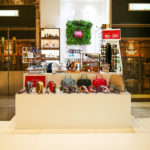Want something more visual? Check out the infographic.
With lockdown restrictions slowly lifting across the world, people are beginning to emerge from their homes and life is making its first tentative steps towards returning to normal. In this article we’ll talk through some of the steps retailers should consider when planning to open a store in a post-Covid world.
While there is much debate as to what the ‘new normal’ will look like post-Covid for retail, what’s clear is that in the short-term, retailers looking to open their doors will have to take steps to ensure the safety of their staff and customers.
Government legislation varies from country to country (check out the French, UK and US guidance) but regardless of what a store is required to do by law there is a more important barometer you need to consider. Yes, of course you need to make sure what you’re doing is within the legal guidelines but the higher benchmark to consider is what your customers expect.
When you consider it this way, waiting for governments to tell us what to do isn’t a necessity. We can anticipate what customers will expect and this is the benchmark that matters, not what we need to do as a legal minimum. Physical stores planning to reopen must convince their customers they will be safe while shopping in their stores.
What your customers require to feel comfortable and relaxed will inevitably be a higher standard than any government policy. It’s not about what we as retailers need to do in order to operate but rather ‘what can we do to make people feel comfortable?’.
In this article we highlight 11 areas that you should consider when planning to reopen an existing store, open a new one or embark on a short-term retail project. There is no one-size-fits-all approach to reopening as this is far from an exhaustive list. Consider your business goals and resources (and how reopening will impact those) as you plan.
If you have any questions please don’t hesitate to get in touch. We’re monitoring the retail landscape across the globe and one of our retail experts would be more than happy to talk through your situation (get in touch here). Otherwise, we hope you find the following useful.

Cleaning all areas of your store regularly is a must. Almost as important as actually cleaning is being seen to be cleaning it and making sure customers know you have a strict cleaning schedule in place.
Depending on your industry and the layout of your store you will need to focus on different areas. Implement a cleaning regime targets frequently touched surfaces and spaces such as shopping carts, pin pads and door handles. Don’t forget to cater for staff equipment; such as vending machines, shared tools such as pricing guns and refrigerators.
2. New safety equipment
Installing safety equipment may seem like an expensive investment but it will serve to reinforce customer confidence in your policies and approach. Customers may not enter if they don’t see clear effort and expense being spent on ensuring their safety. Make sure the safety equipment is well maintained and clear and evident, it shouldn’t be something you’re embarrassed about or try to hide.
First off, consider installing plastic screens at checkouts then perhaps put a hand sanitizer station near the door.
3. PPE
Regardless of the location of your store you will need to consider PPE. Even if it isn’t mandatory where you are in the world is it something that will reassure your customers? The answer’s probably yes. Make sure you have a reliable source of PPE for all staff and that they are fully trained in how to wear it and when. You will also need to ensure you have a consistent approach to cleaning your PPE.
Depending on where you are it may be wise to make it mandatory for all customers to wear some level of PPE in order to enter.
4. Social distancing
It’s a likely social distancing will probably be standard practice for a while yet and possibly longer. At the very least, people’s awareness of their own personal space is heightened and doing what you can to make people feel comfortable will be integral.
Make it store policy to maintain a two metre distance between everyone (including staff) and put markers on the floor in areas likely to experience a queue such as the checkout.
Other options. that very much depend on the specific setup of your store, include implementing one-way and clearly signed ‘flows’ that encourage customers to walk a specific way around the store, thereby minimising the chances of encountering someone else coming the other way. Another option, if you have two doors, is to have separate entrances and exits.
If your store is relatively small it may be sensible to create a capacity limit. Clearly sign how many people are allowed in the store and ensure that a member of staff is at the door to enforce the policy. If you expect to have large numbers of people outside queuing make sure you consider their safety as well and put markers where they can queue outside while maintaining social distancing.
5. Your staff
Throughout the process of opening your store never forget about your staff. Their safety should be as important to you as that of your customers, if not more so. Equally, their adherence to your new policies will be a huge contributor as to whether they are successful and customers feel comfortable enough to enter, purchase and tell their friends. To this end, ensure you train your staff well and that they understand the role they need to play.
In terms of shifts, try and balance shifts so that there aren’t too many people on breaks simultaneously to avoid crowding in ‘break’ areas.
6. Signage

You should look to clearly sign the steps you have taken and clearly explain your policies. Make them reassuring and highly visible so that customers know you are taking their safety seriously. Clear messages reiterating social distancing requirements, volumes of customers or some of your safety processes will provide an environment of reassurance and consistency. You could even use in-store announcements to remind customers of proper traffic flow and social distancing protocols.
7. Returns
In a post-Covid world you need to think about how you’re going to manage returns. At first it may be sensible to consider extending your standard returns policy until well after lockdown ends.
Is it enough to wash them when they come back, and will customers want to buy potentially contaminated clothing? These are things you need to consider – make sure you clearly sign your policies to reassure customers.
8. Opening hours
When you reopen don’t automatically resume the same trading hours. You may wish to extend them or even shorten them. Bear in mind that social distancing requirements and your cleaning processes will mean it takes longer to open and shut your store.
Adjust store hours of operation, as necessary, to support social distancing efforts by limiting store traffic. Consider offering seniors and other high-risk individuals exclusive early hours access and perhaps increase pickup hours to serve more online customers.
9. Changing rooms
For fashion and apparel brands changing rooms are a staple and required part of the sales process but they represent some significant challenges in the immediate future. It may be sensible to keep changing rooms closed unless you can limit numbers and have in place a robust cleaning or decontamination process.
If you do decide to open your changing rooms, position a member of staff nearby to ensure social distancing is maintained and to immediately clear away items that have been handled.
10. Contactless only?
Handling money poses challenges. It would be sensible to only accept card payments and to maximise how much you use contactless. If contactless is not possible (some countries have extended the limit for the duration of the crisis) then ensure you disinfect the pin pad before and after every transaction – and make sure the customer sees you do it.
11. Shopping by appointment
Finally, one trend we are seeing more and more of is a switch to shopping by appointment. This is where customers book a time slot where they can come into the store. During this time they are the only person in that store and have the full (socially distanced) attention of staff. Obviously, this is not an option for all retailers but is an extremely valid option for high-end goods or fashion and apparel brands.
Consumer confidence will return when they are confident their safety is a priority
Consumer confidence, as has been witnessed in China, will return. While we need to be realistic and not expect floods of people from the start, people are keen to get back to normal. Retailers looking to open their doors should do everything in their power to not dissuade people and take steps to show physical retail is safe.
If you are wondering about the role of physical retail in a post-Covid world have a read of this article.
If you want to talk through any of the points in this article with one of our retail experts please drop us a line. We’d be happy to help.




